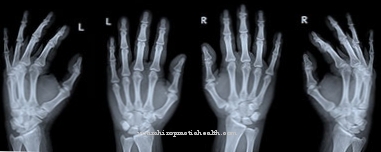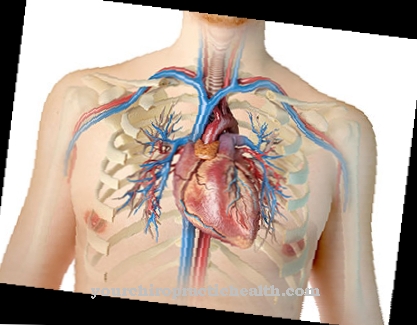The Rotor Syndrome is a disorder of the bilirubin metabolism, which is assigned to hereditary diseases. The main symptoms are jaundice and an increased blood level of direct bilirubin. The disease is usually not treated because the patients usually show no symptoms except for jaundice.
What is Rotor Syndrome?

© daniiD - stock.adobe.com
A breakdown product of hemoglobin is known as bilirubin, which is released when old erythrocytes in the spleen and liver are broken down. Heme oxygenase and biliverdin reductase turn the heme into bilirubin, which in the bilirubin is bound to albumin. These processes are also summarized under the term bilirubin metabolism.
The ICD-10 recognizes different disorders of the porphyrin and bilirubin metabolism. One of them is this Rotor Syndrome, also called Rotor-Manahan-Florentin Syndrome is titled. It is a rare, benign, autosomal recessive disease that affects bilirubin metabolism. The main symptoms of the disease are an unusually high bilirubin level and jaundice.
So far, the syndrome has been little researched in Western society due to its rarity and largely irrelevant. Nonetheless, more and more western scientists are expressing interest in the disorder, as they hope that the study will provide an insight into transport processes in the liver.
The Filipino doctors Florentin, Manahan and Rotor first described the disorder and initially equated it with Dubin-Johnson syndrome. Wolkoff and colleagues proved in the 1970s that Rotor and Dubin-Johnson syndromes are different clinical pictures.
causes
The hyperbilirubinemia and the resulting jaundice of Rotor syndrome are caused by an intracellular storage disorder of conjugated and unconjugated bilirubin. Rotor syndrome can affect both sexes. The syndrome occurs predominantly in the Philippines and is hereditary. Familial accumulation was observed in the cases documented so far.
A predominantly genetic cause is therefore obvious. The fact that Rotor Syndrome almost exclusively affects the Philippines may, however, also be related to exogenous factors that could promote the outbreak of the syndrome under certain circumstances. The genetic cause is speculated above all about a defect that makes the transport of conjugated bilirubin more difficult and could make it more difficult to remove the substance from the liver cell into the area of the bile ducts.
The syndrome is probably based on a hereditary MRP-2-channel defect due to mutations. The original mutation has not yet been identified and could therefore affect all genes that are involved in the coding of channel components. It is also unclear which exogenous factors could further promote the outbreak of the disease. Presumably, the coming decade will provide more clarity after Western science is currently showing great interest in researching the disease.
Symptoms, ailments & signs
Rotor syndrome is primarily characterized by jaundice. The patients therefore suffer from jaundice, which can manifest itself on the skin, in the eyes or even in the internal organs. In addition, there is hyperbilirubinemia. Such is the case if the bilirubin concentration increases above 1.1 mg / dl.
These symptoms can be associated with other complaints, which, however, are rather unspecific and do not necessarily have to be present. Some patients also complain about unspecific complaints and pain in the right upper abdominal area. The pain symptoms in the upper abdomen are comparatively rare, so that they cannot be used as a diagnostic criterion.
Nonetheless, the pain in the right upper abdomen can corroborate a Rotor Syndrome diagnosis based on the remaining symptoms. The same applies to possible accompanying symptoms such as fever attacks. Typically, hyperbilirubinemia and jaundice appear as isolated phenomena. Underactive enzymatic functions or a lack of enzymes involved in breakdown are not symptoms of Rotor Syndrome.
Diagnosis & course of disease
Hyperbilirubinemia is the key diagnostic symptom of Rotor syndrome. The high concentration of the degradation product can be demonstrated in the blood by means of laboratory tests. It is an increase in direct bilirubin between three and ten mg / dl. The patient does not show any signs of hemolysis. The same applies to hepatopathy with cell necrosis.
The transaminase values are always in the normal range, with the alkaline phosphatase also showing normal activity. In a differential diagnosis, the doctor must differentiate between jaundice in patients and jaundice in newborns and infants, and accordingly differentiate it from hemolytic anemia, hepatitis and any conjugation disorders of bilirubin.
Beyond the differential diagnostic distinction from Crigler-Najjar syndrome or Gilbert-Meulengracht's disease, malformations of the biliary tract as a cause of jaundice must be ruled out for the diagnosis of Rotor syndrome.
Complications
In most cases, Rotor syndrome does not require special treatment because it does not present any serious or harmful symptoms. The life expectancy of the patient is usually neither restricted nor reduced. With this disease, those affected primarily suffer from severe jaundice. This complaint can lead to bullying or teasing, especially among children or adolescents, so that these age groups often suffer from depression or other psychological complaints.
However, adults can also develop inferiority complexes or a reduced self-esteem. There may be pain in the upper abdomen, although this is usually not associated with food intake. Fever attacks can also occur with this syndrome and have a negative effect on the quality of life of the person affected.
Usually there are no further complications or complaints. The complaints do not impair the life of those affected and for this reason are not treated. Only the fever can be treated with medication. Unfortunately, rotor syndrome prevention is also not possible.
When should you go to the doctor?
A doctor should generally always be consulted in the case of Rotor syndrome. This disease does not heal itself and in most cases the symptoms worsen if the disease is not treated properly. Medical treatment is therefore essential. A doctor should be consulted if the person concerned is suffering from very severe pain in the upper abdomen. The pain can also spread to neighboring regions of the body and have a very negative effect on the patient's quality of life.
In most cases, people also have a high fever and the usual symptoms of the flu or cold. The quality of life is significantly reduced by the rotor syndrome. Jaundice can also indicate the disease. If these symptoms occur over a longer period of time and do not go away on their own, a doctor must be consulted in any case. As a rule, Rotor Syndrome can be detected and treated relatively easily by a general practitioner.
Treatment & Therapy
The exact causes of the Rotor Syndrome have not yet been conclusively established and are therefore still in the sphere of the speculative. For this reason alone, no causal treatment of the disease can take place. As a rule, symptomatic treatment is also not required.
If severe upper abdominal pain is present as an accompanying symptom, symptomatic relief can be provided with pain reliever medication. Antipyretic medication can be used for accompanying fever attacks. In most cases, however, Rotor syndrome hardly affects the patient, so that no therapeutic steps are required.
You can find your medication here
➔ Medicines for jaundice and liver problemsprevention
Since the causes of Rotor Syndrome have not been conclusively clarified, the phenomenon cannot yet be prevented. Because of the apparently hereditary basis of the disease, those affected can theoretically make a prophylactic decision against having their own children. However, since Rotor Syndrome does not seriously affect the lives of those affected, such an approach is rather too radical.
Aftercare
Patients with Rotor syndrome usually do not require extensive follow-up care. As the disease occurs rarely, there are no specific follow-up methods. Follow-up care is based on the extent to which the symptoms occur. The symptoms of the disease are usually harmless and subside without any consequences.
After recovery, a doctor should assess the patient's health. The typical symptoms such as fever, abdominal pain and the yellowing of the skin must be examined by a doctor so that secondary symptoms can be excluded. If you have a severe fever, your doctor can advise you about further recovery measures. If the abdominal pain persists, an X-ray examination can clarify the possible causes.
In this way, for example, internal bleeding can be detected. If the symptoms of Rotor syndrome occur, there may be an undiagnosed liver disease. Follow-up care is provided by the family doctor or the internist. If you have chronic liver problems, you should visit the doctor regularly.
Follow-up care takes place in the doctor's practice or in a specialist clinic, depending on the underlying disease. If the Rotor syndrome occurs again, the doctor must be informed. A causal treatment may also be necessary. The specialist can name the appropriate measures and prescribe the patient a suitable pain reliever after the jaundice has healed.
You can do that yourself
Patients suffering from Rotor syndrome must attend regular doctor visits. The liver function must be checked every three to six months so that complications can be excluded. Due to the dysfunction of the liver, the diet must be changed. The nutrition plan must be strictly adhered to so that no complaints occur.
Home remedies such as warming pads and light foods help with stomach pain. Herbal teas with chamomile or lemon balm also alleviate the typical complaints and contribute to a quick recovery. If the symptoms persist, it is best to consult the responsible family doctor or gastroenterologist. If complications such as severe fever attacks or pain reactions occur, a visit to a doctor is also recommended. If there are signs of a liver infarction, the emergency doctor must be called. The patient must then be placed quietly. The arriving rescue service must be informed of the condition so that the necessary medical measures can be initiated immediately.
General measures such as rest and rest apply after a hospital stay. Parents of affected children should have the necessary examinations carried out if they want to have children again. This allows the risk of illness to be assessed and the doctor can suggest further measures if necessary.



.jpg)
.jpg)
.jpg)






.jpg)



.jpg)










.jpg)
